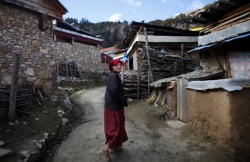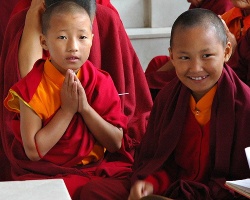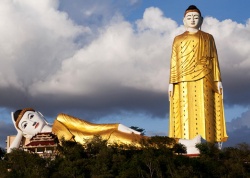Difference between revisions of "Dharmas with anxiety and without: Suffering"
| Line 1: | Line 1: | ||
| − | <nomobile>{{DisplayImages|2853|2141|123 | + | <nomobile>{{DisplayImages|2853|2141|123}}</nomobile> |
| + | |||
| + | |||
<poem> | <poem> | ||
| − | One of the most significant features of dharma-elements in [[Buddhism]] [[philosophy]] is that they are creating so called “[[dukha]]”, a notion that is usually translated as “[[suffering]]”, “sorrows”, etc. but in {{Wiki|theory}} it implies some other meaning. Such statements as “the [[sight]] [[element]] is [[dukha]]” (AK1; 19), “all [[elements]] [[conditioned]] by willpower are [[dukha]]” (AK1; 9) and also the [[element]] of {{Wiki|colour}} is tied with [[sufferings]] (AK1; 8), would be difficult to understand, if we would apply our common [[understanding]] about what are [[sufferings]]. | + | One of the most significant features of dharma-elements in [[Buddhism]] [[philosophy]] is that they are creating so called “[[dukha]]”, a notion that is usually translated as “[[suffering]]”, “sorrows”, etc. but in {{Wiki|theory}} it implies some other meaning. |
| + | |||
| + | Such statements as “the [[sight]] [[element]] is [[dukha]]” (AK1; 19), “all [[elements]] [[conditioned]] by willpower are [[dukha]]” (AK1; 9) and also the [[element]] of {{Wiki|colour}} is tied with [[sufferings]] (AK1; 8), would be difficult to understand, if we would apply our common [[understanding]] about what are [[sufferings]]. | ||
| − | |||
| − | Our [[understanding]] about the [[element]] ([[dharma]]) would not be complete, if we would not imply in this notion the [[thought]] about the [[anxiety]] that have to be eliminated and the {{Wiki|theory}} of [[non-substantiality]] and momentary [[disappearance]]. This feature turns the [[teaching]] on [[dharmas]] into [[teaching]] about {{Wiki|salvation}} – the most important goal of both the {{Wiki|theoretical}} and {{Wiki|practical}} [[Buddhism]]. | + | |
| + | Here we should remember that all [[dharma]] [[elements]] are in a [[constant]] [[state]] of [[anxiety]], but the final goal of the world’s process is [[gradual]] pacifying and [[cessation]] of them. | ||
| + | |||
| + | [[Vasubandhu]] (AK1;1) make a conclusion that [[Buddha]], due to his [[compassion]] to the misfortunes of [[human beings]], has discovered a method of {{Wiki|salvation}}, which doesn’t demand any [[magical]] or [[religious]] wonders, but which is created by the method how to end forever the [[anxiety]], which is created by the [[powers]] from which the active [[life]] process consist. | ||
| + | |||
| + | |||
| + | |||
| + | Our [[understanding]] about the [[element]] ([[dharma]]) would not be complete, if we would not imply in this notion the [[thought]] about the [[anxiety]] that have to be eliminated and the {{Wiki|theory}} of [[non-substantiality]] and momentary [[disappearance]]. | ||
| + | |||
| + | This feature turns the [[teaching]] on [[dharmas]] into [[teaching]] about {{Wiki|salvation}} – the most important goal of both the {{Wiki|theoretical}} and {{Wiki|practical}} [[Buddhism]]. | ||
From the point of view of [[gradual]] {{Wiki|movement}} to the final [[liberation]], all [[elements]] can be characterised by two kinds: | From the point of view of [[gradual]] {{Wiki|movement}} to the final [[liberation]], all [[elements]] can be characterised by two kinds: | ||
| Line 14: | Line 26: | ||
[[Anasrava]] (“Uncontaminated”, “not connected with [[anxiety]]”) – the opposite tendency – towards [[cessation]] of [[being]], {{Wiki|decrease}} of [[anxiety]] or even final elimination. | [[Anasrava]] (“Uncontaminated”, “not connected with [[anxiety]]”) – the opposite tendency – towards [[cessation]] of [[being]], {{Wiki|decrease}} of [[anxiety]] or even final elimination. | ||
| − | |||
| − | Previously in connection to the notion of “[[Abhidharma]]” it was said these [[dharmas]] are a “[[Path]]” to [[liberation]]. Other [[dharmas]] that are subordinated to the process of [[existence]] are closely related to the [[elements]] of [[passion]] and [[anxiety]], in the [[sense]] of will of [[life]], and for this [[reason]] are called [[dharmas]] of [[anxiety]]. [[Passions]] (kleša) as separate [[elements]], i.e. substantial entities, [[influence]] the flow of [[life]] ([[santana]]) to which they adhere. | + | |
| + | [[Dharmas]] „without [[anxiety]]” are those, mentioned in my previous post, [[unconditioned]] or [[asamskrta dharmas]], but also a part of the [[conditioned]] [[dharmas]] i.e. subordinated to the process of [[existence]]. | ||
| + | |||
| + | Those [[dharmas]], for example the [[element]] of [[Enlightenment]] and some others tied with it, are called “without [[anxiety]]”, because [[elements]] of {{Wiki|chaos}} that support the [[cycle of existence]], in their presence cannot find any support. | ||
| + | |||
| + | Previously in connection to the notion of “[[Abhidharma]]” it was said these [[dharmas]] are a “[[Path]]” to [[liberation]]. | ||
| + | |||
| + | Other [[dharmas]] that are subordinated to the process of [[existence]] are closely related to the [[elements]] of [[passion]] and [[anxiety]], in the [[sense]] of will of [[life]], and for this [[reason]] are called [[dharmas]] of [[anxiety]]. [[Passions]] (kleša) as separate [[elements]], i.e. substantial entities, [[influence]] the flow of [[life]] ([[santana]]) to which they adhere. | ||
The first row of [[elements]] ([[sāsrava-dharma]]) approximately correspond to an average [[person]] with all his sorrows and joys, the second represents a [[saint]] [[person]], which is not involved in the [[selfish]] worries of ordinary [[life]] and worries only for the final [[liberation]]. | The first row of [[elements]] ([[sāsrava-dharma]]) approximately correspond to an average [[person]] with all his sorrows and joys, the second represents a [[saint]] [[person]], which is not involved in the [[selfish]] worries of ordinary [[life]] and worries only for the final [[liberation]]. | ||
Latest revision as of 07:59, 26 October 2015
One of the most significant features of dharma-elements in Buddhism philosophy is that they are creating so called “dukha”, a notion that is usually translated as “suffering”, “sorrows”, etc. but in theory it implies some other meaning.
Such statements as “the sight element is dukha” (AK1; 19), “all elements conditioned by willpower are dukha” (AK1; 9) and also the element of colour is tied with sufferings (AK1; 8), would be difficult to understand, if we would apply our common understanding about what are sufferings.
Here we should remember that all dharma elements are in a constant state of anxiety, but the final goal of the world’s process is gradual pacifying and cessation of them.
Vasubandhu (AK1;1) make a conclusion that Buddha, due to his compassion to the misfortunes of human beings, has discovered a method of salvation, which doesn’t demand any magical or religious wonders, but which is created by the method how to end forever the anxiety, which is created by the powers from which the active life process consist.
Our understanding about the element (dharma) would not be complete, if we would not imply in this notion the thought about the anxiety that have to be eliminated and the theory of non-substantiality and momentary disappearance.
This feature turns the teaching on dharmas into teaching about salvation – the most important goal of both the theoretical and practical Buddhism.
From the point of view of gradual movement to the final liberation, all elements can be characterised by two kinds:
Sāsrava (“Contaminated”, “connected with anxiety”, “because the defilements adhere to them”) – with tendency towards being, anxiety and mess. Or
Anasrava (“Uncontaminated”, “not connected with anxiety”) – the opposite tendency – towards cessation of being, decrease of anxiety or even final elimination.
Dharmas „without anxiety” are those, mentioned in my previous post, unconditioned or asamskrta dharmas, but also a part of the conditioned dharmas i.e. subordinated to the process of existence.
Those dharmas, for example the element of Enlightenment and some others tied with it, are called “without anxiety”, because elements of chaos that support the cycle of existence, in their presence cannot find any support.
Previously in connection to the notion of “Abhidharma” it was said these dharmas are a “Path” to liberation.
Other dharmas that are subordinated to the process of existence are closely related to the elements of passion and anxiety, in the sense of will of life, and for this reason are called dharmas of anxiety. Passions (kleša) as separate elements, i.e. substantial entities, influence the flow of life (santana) to which they adhere.
The first row of elements (sāsrava-dharma) approximately correspond to an average person with all his sorrows and joys, the second represents a saint person, which is not involved in the selfish worries of ordinary life and worries only for the final liberation.
Profound knowledge of all elements of existence, precise discrimination of them is important for the liberation, because if you know them, you can choose them and suppress gradually one after another.


